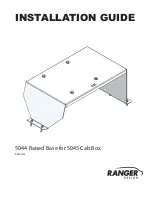
receives power from the Fuse Block No. 1. When-
ever the ignition key is turned to the run or start
position, the ACM performs a system test. The ACM
cannot be repaired or adjusted.
The microprocessor in the ACM monitors the
internal and external airbag system electrical cir-
cuits to determine the system readiness. When a
monitored system is determine to be out of range,
the ACM will set both active and stored diagnostic
trouble codes (DTC). The ACM also contains an
energy-storage capacitor. This capacitor stores
enough electrical energy to deploy the front airbag
components for two seconds following a battery
disconnect or failure during an impact.
The Accelerometer in the ACM is used to sense
the rate of vehicle deceleration, provide verification
of the direction and severity of an impact. When the
preprogrammed conditions are met, the ACM sends
an electrical signal to deploy the appropriate front
airbag system components and a deployment noti-
fication.
To provide an accident response notification, the
ACM is hardwired to the Central Timer module
(CTM) and Engine Control Module (ECM). When a
deployment occurs the ACM provides a 50ms 10.0
volt pulse to the CTM and ECM. When the Accident
Report notification signal is received the CTM un-
locks the door locks and the ECM stalls the engine.
The Accident signal will set a DTC in the CTM and
the door locks will not work until the DTC has been
erased. The ECM will set a DTC if the Accident
Report circuit is shorted to battery voltage. The
ACM saves the deployment record and after three
deployments the ACM must be replaced. The
DRBIII
t
can be used to test the Accident Report
Notification feature: select the SYSTEM TEST from
the ACM main menu. Then select the Analog Crash
Output System Test.
The ACM is hardwired to the Instrument Cluster
(MIC) to control Warning Indicator (SRS indicator).
When DTCs becomes activate, the ACM illuminates
the Warning Indicator by pulling the indicator
circuit low. The SRS indicator is the only point at
which the customer can observe symptoms of a
system malfunction.
As part of the system test the ACM illuminates
the Warning Indicator on for 4.0 second bulb test.
After the lamp check, if the indicator turns off, it
means that the ACM has checked the system and
found it to be free of discernible malfunctions.
NON-CRITICAL DTCs
If the lamp comes on and stays on for a period
longer than 4.0 seconds (about 10.0 seconds) is
usually a stored DTC (intermittent problem) in the
system.
CRITICAL DTCs
DTCs that could lead to a condition where the
safety devises may not deploy or incorrectly deploy.
In the event of such a DTC, the safety of the vehicle
occupants can no longer be guaranteed. If the lamp
remains on, there could be an active DTC in the
system. Some DTCs, Internal Module and squib
DTCs, will keep the indicator illuminated even if
the codes are no longer active.
ACM NOT CONFIGURED FOR PASSENGER
AIRBAG AND TENSIONER
If after replacing the ACM the Airbag Warning
Indicator flashes continuously the ACM must be
configured for the Passenger Airbag and Tensioner.
Select Miscellaneous from the ACM main menu and
configure the Passenger Airbag Tensioner squibs.
WARNING:
THE
AIRBAG
SYSTEM
IS
A
SENSITIVE, COMPLEX ELECTROMECHANICAL
UNIT. BEFORE ATTEMPTING TO DIAGNOSE OR
SERVICE ANY AIRBAG SYSTEM OR RELATED
STEERING WHEEL, STEERING COLUMN, OR
INSTRUMENT PANEL COMPONENTS YOU MUST
FIRST
DISCONNECT
AND
ISOLATE
THE
BATTERY NEGATIVE (GROUND) CABLE. WAIT
TWO MINUTES FOR THE SYSTEM CAPACITOR
TO DISCHARGE BEFORE FURTHER SYSTEM
SERVICE. THIS IS THE ONLY SURE WAY TO
DISABLE THE AIRBAG SYSTEM. FAILURE TO
DO THIS COULD RESULT IN ACCIDENTAL
AIRBAG
DEPLOYMENT
AND
POSSIBLE
PERSONAL INJURY.
WARNING: TO AVOID PERSONAL INJURY OR
DEATH,
NEVER
STRIKE
OR
KICK
THE
AIRBAG CONTROL MODULE, AS IT CAN
DAMAGE THE IMPACT SENSOR OR AFFECT
ITS CALIBRATION.
WARNING:
IF
AN
AIRBAG
CONTROL
MODULE
IS
ACCIDENTALLY
DROPPED
DURING SERVICE, THE MODULE MUST BE
SCRAPPED AND REPLACED WITH A NEW
UNIT. FAILURE TO TAKE THE PROPER
PRECAUTIONS
COULD
RESULT
IN
ACCIDENTAL AIRBAG DEPLOYMENT AND
PERSONAL INJURY OR DEATH.
3.1.1
DRIVER AIRBAG
The airbag protective trim cover is the most
visible part of the driver side airbag system. The
airbag is mounted directly to the steering wheel.
Located under the trim cover are the airbag cushion
and the airbag cushion supporting components.
2
GENERAL INFORMATION
Summary of Contents for Sprinter 2003
Page 8: ...NOTES viii ...
Page 22: ...NOTES 14 ...
Page 23: ...7 0 DIAGNOSTIC INFORMATION AND PROCEDURES 15 ...
Page 255: ...8 9 3 SWITCHES 8 9 4 SIREN C O M P O N E N T L O C A T I O N S 247 COMPONENT LOCATIONS ...
Page 256: ...NOTES 248 ...
Page 267: ...C O N N E C T O R P I N O U T S 259 CONNECTOR PINOUTS ...
Page 273: ...C O N N E C T O R P I N O U T S 265 CONNECTOR PINOUTS ...
Page 280: ...NOTES 272 ...
Page 283: ...10 2 2 CAN BUS NETWORK S C H E M A T I C D I A G R A M S 275 SCHEMATIC DIAGRAMS ...
Page 285: ...10 3 2 CABIN HEATER MODULE CHM S C H E M A T I C D I A G R A M S 277 SCHEMATIC DIAGRAMS ...
Page 287: ...10 4 INSTRUMENT CLUSTER S C H E M A T I C D I A G R A M S 279 SCHEMATIC DIAGRAMS ...
Page 289: ...10 5 2 SLIDING AND REAR DOORS S C H E M A T I C D I A G R A M S 281 SCHEMATIC DIAGRAMS ...
Page 291: ...10 6 VEHICLE THEFT SECURITY SYSTEM S C H E M A T I C D I A G R A M S 283 SCHEMATIC DIAGRAMS ...
Page 292: ...NOTES 284 ...
Page 294: ...NOTES 286 ...
Page 296: ...Dealer Technical Operations 800 Chrysler Drive CIMS 486 02 76 Auburn Hills MI 48326 2757 ...











































